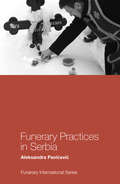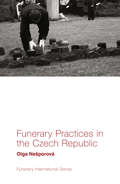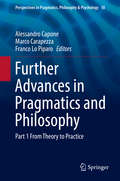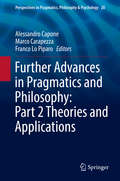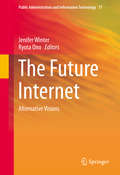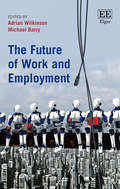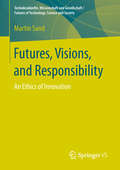- Table View
- List View
Fundamentals of Psychology: An Introduction
by Michael S. GazzanigaFundamentals of Psychology: An Introduction focuses on issues that cut through the artificial boundaries commonly held in the study of behavior. The book reviews the nature of the organism in terms of basic neurology, including the neurological organization of the central nervous system and the general features of brain development. The author also examines the normal course of development of the visual systems. He discusses fixed patterns of behavior and the developmental processes that include emotional behavior, self-control, language use, perceptual, and cognitive development. The author then explains the use of statistical concept in psychological research, as well as the psychological methods of inquiry that involves variable manipulation and observation of effects. The author also discusses learning and motivation theory including the theories of Pavlov, Skinner, and Premack. He discusses the organism as an information processor using short- and long-term memory, and the mind as having physical aspects such as brain codes and a brain structure known as the corpus callosum. This book is helpful for psychiatrists, psychologists, behavioral scientists, students and professors in psychology.
Fundamentals of Roman Private Law
by George MousourakisRoman law forms a vital part of the intellectual background of many legal systems currently in force in Continental Europe, Latin America, East Asia and other parts of the world. Knowledge of Roman law, therefore, constitutes an essential component of a sound legal education as well as the education of the student of history. This book begins with a historical introduction, which traces the evolution of Roman law from the earliest period of Roman history up to and including Justinian's codification in the sixth century AD. Then follows an exposition of the principal institutions of Roman private law: the body of rules and principles relating to individuals in Roman society and regulating their personal and proprietary relationships. In this part of the book special attention is given to the Roman law of things, which forged the foundations for much of the modern law of property and obligations in European legal systems. Combining a law specialist's informed perspective with a historical and cultural focus, the book provides an accessible source of reference for students and researchers in many diverse fields of legal and historical learning.
Funerary Practices in England and Wales (Funerary International)
by Julie Rugg Brian ParsonsThe Funerary International series comprises essential reference texts for policy-makers, practitioners and academics with an interest in funerary practices globally. Each book has a country or region specific focus, addressing a standard framework of questions to aid comparison. This book sets English and Welsh funerary practice in its wider legal, national and local governance framework, including the continuing role of the Church of England. It provides the historical context for current practice, provides data on new trends in burial and cremation and examines recent developments including direct cremation and alkaline hydrolysis. It provides detail of current practice and includes a detailed description of a typical funeral, including commemorative practice, and discussion of funeral costs. Chapters address the legalities and technicalities of burial and cremation, explaining the concept of burial rights and the technicalities of grave construction, and outlining cremation certification requirements and the process of cremation. This book is a valuable desk-top resource to give a broader frame of reference for policy makers, and to provide explanation of key concepts for practitioners who may be new to this area of work. The text will be of particular value to academics that may be unfamiliar with the legal, technical and professional aspects of the funerary industry. The text is fully referenced, with an additional bibliography of further reading, and includes illustrations, charts, tables, diagrams and boxed text including key information.
Funerary Practices in England and Wales (Funerary International)
by Julie Rugg Brian ParsonsThe Funerary International series comprises essential reference texts for policy-makers, practitioners and academics with an interest in funerary practices globally. Each book has a country or region specific focus, addressing a standard framework of questions to aid comparison. This book sets English and Welsh funerary practice in its wider legal, national and local governance framework, including the continuing role of the Church of England. It provides the historical context for current practice, provides data on new trends in burial and cremation and examines recent developments including direct cremation and alkaline hydrolysis. It provides detail of current practice and includes a detailed description of a typical funeral, including commemorative practice, and discussion of funeral costs. Chapters address the legalities and technicalities of burial and cremation, explaining the concept of burial rights and the technicalities of grave construction, and outlining cremation certification requirements and the process of cremation. This book is a valuable desk-top resource to give a broader frame of reference for policy makers, and to provide explanation of key concepts for practitioners who may be new to this area of work. The text will be of particular value to academics that may be unfamiliar with the legal, technical and professional aspects of the funerary industry. The text is fully referenced, with an additional bibliography of further reading, and includes illustrations, charts, tables, diagrams and boxed text including key information.
Funerary Practices in Serbia (Funerary International)
by Aleksandra PavićevićFunerary Practices in Serbia is the first book to offer a concise yet highly informative study of the historical development and current state of funerary practices in Serbia. Situated in a constant dynamic struggle between traditional cultural customs and modern legislation, funerary practices in Serbia represent a particularly interesting field of research. In this study, Pavićević combines an investigation of long-term developments and recent changes to place contemporary practices in their wider historical context, emphasizing the complicated geo-political, demographic and cultural factors that have shaped funeral traditions in Serbia over time. In particular, she demonstrates how the country's frequent changing of borders and life under the rule of two great empires - the Austro-Hungarian and Ottoman - fostered the emergence of colorful funerary traditions, such as open-casket burial and vigils around the body, that persist to this day in spite of government attempts to modernize funerary practice since the end of the 19th century. The book also provides illuminating insights into the legal framework surrounding current funerary practices in Serbia, the relationship between the state and private sectors, the ownership of cemeteries and gravesites, the role of churches and religious communities, religious and ethnic variations in funerary culture and traditions, and the development of modern cremation practices in Serbia. This book provides a useful and original resource for policymakers and practitioners interested in the historic, legal, technical and professional aspects of the Serbian funerary industry, and to researchers in cultural anthropology, history, sociology and cultural management.
Funerary Practices in Serbia (Funerary International)
by Aleksandra PavićevićFunerary Practices in Serbia is the first book to offer a concise yet highly informative study of the historical development and current state of funerary practices in Serbia. Situated in a constant dynamic struggle between traditional cultural customs and modern legislation, funerary practices in Serbia represent a particularly interesting field of research. In this study, Pavićević combines an investigation of long-term developments and recent changes to place contemporary practices in their wider historical context, emphasizing the complicated geo-political, demographic and cultural factors that have shaped funeral traditions in Serbia over time. In particular, she demonstrates how the country's frequent changing of borders and life under the rule of two great empires - the Austro-Hungarian and Ottoman - fostered the emergence of colorful funerary traditions, such as open-casket burial and vigils around the body, that persist to this day in spite of government attempts to modernize funerary practice since the end of the 19th century. The book also provides illuminating insights into the legal framework surrounding current funerary practices in Serbia, the relationship between the state and private sectors, the ownership of cemeteries and gravesites, the role of churches and religious communities, religious and ethnic variations in funerary culture and traditions, and the development of modern cremation practices in Serbia. This book provides a useful and original resource for policymakers and practitioners interested in the historic, legal, technical and professional aspects of the Serbian funerary industry, and to researchers in cultural anthropology, history, sociology and cultural management.
Funerary Practices in the Czech Republic (Funerary International)
by Olga NešporováThis book offers the first comprehensive study of Czech funerary practices to be published in English. It provides an in-depth account of the historical development of funeral traditions and customs in the Czech Lands from the beginning of the 20th century to the present day. Czech funerary practice is today characterised by a very high cremation rate, the predominance of secular funerals and the increasing popularity of cremation with no funeral ceremony. Combining investigation of both long-term developments and recent changes, this book places these contemporary practices in their wider historical context, highlighting the complicated religious, political and cultural factors that have influenced funeral traditions over time. Nešporová draws attention to the extent to which the turbulent political background of the 20th century shaped funerary culture, focusing particularly on the cremation movement and the increase in popularity of civil funerals during the Communist era. The book explores the contemporary legal framework of Czech funerary practices, the typical funeral, burial sites and commemorative practices and recent developments in Czech funerary practice. The book will appeal to a multi-disciplinary audience, including those working in the fields of cultural anthropology, history, sociology and architecture.
Funerary Practices in the Czech Republic (Funerary International)
by Olga NešporováThis book offers the first comprehensive study of Czech funerary practices to be published in English. It provides an in-depth account of the historical development of funeral traditions and customs in the Czech Lands from the beginning of the 20th century to the present day. Czech funerary practice is today characterised by a very high cremation rate, the predominance of secular funerals and the increasing popularity of cremation with no funeral ceremony. Combining investigation of both long-term developments and recent changes, this book places these contemporary practices in their wider historical context, highlighting the complicated religious, political and cultural factors that have influenced funeral traditions over time. Nešporová draws attention to the extent to which the turbulent political background of the 20th century shaped funerary culture, focusing particularly on the cremation movement and the increase in popularity of civil funerals during the Communist era. The book explores the contemporary legal framework of Czech funerary practices, the typical funeral, burial sites and commemorative practices and recent developments in Czech funerary practice. The book will appeal to a multi-disciplinary audience, including those working in the fields of cultural anthropology, history, sociology and architecture.
Fungipedia: A Brief Compendium of Mushroom Lore
by Fungipedia Lawrence MillmanAn illustrated mini-encyclopedia of fungal lore, from John Cage and Terrence McKenna to mushroom sex and fairy ringsFungipedia presents a delightful A–Z treasury of mushroom lore. With more than 180 entries—on topics as varied as Alice in Wonderland, chestnut blight, medicinal mushrooms, poisonings, Santa Claus, and waxy caps—this collection will transport both general readers and specialists into the remarkable universe of fungi.Combining ecological, ethnographic, historical, and contemporary knowledge, author and mycologist Lawrence Millman discusses how mushrooms are much more closely related to humans than to plants, how they engage in sex, how insects farm them, and how certain species happily dine on leftover radiation, cockroach antennae, and dung. He explores the lives of individuals like African American scientist George Washington Carver, who specialized in crop diseases caused by fungi; Beatrix Potter, creator of Peter Rabbit, who was prevented from becoming a professional mycologist because she was a woman; and Gordon Wasson, a J. P. Morgan vice-president who almost single-handedly introduced the world to magic mushrooms. Millman considers why fungi are among the most significant organisms on our planet and how they are currently being affected by destructive human behavior, including climate change.With charming drawings by artist and illustrator Amy Jean Porter, Fungipedia offers a treasure trove of scientific and cultural information. The world of mushrooms lies right at your door—be amazed!
Fungipedia: A Brief Compendium of Mushroom Lore
by Fungipedia Lawrence MillmanAn illustrated mini-encyclopedia of fungal lore, from John Cage and Terrence McKenna to mushroom sex and fairy ringsFungipedia presents a delightful A–Z treasury of mushroom lore. With more than 180 entries—on topics as varied as Alice in Wonderland, chestnut blight, medicinal mushrooms, poisonings, Santa Claus, and waxy caps—this collection will transport both general readers and specialists into the remarkable universe of fungi.Combining ecological, ethnographic, historical, and contemporary knowledge, author and mycologist Lawrence Millman discusses how mushrooms are much more closely related to humans than to plants, how they engage in sex, how insects farm them, and how certain species happily dine on leftover radiation, cockroach antennae, and dung. He explores the lives of individuals like African American scientist George Washington Carver, who specialized in crop diseases caused by fungi; Beatrix Potter, creator of Peter Rabbit, who was prevented from becoming a professional mycologist because she was a woman; and Gordon Wasson, a J. P. Morgan vice-president who almost single-handedly introduced the world to magic mushrooms. Millman considers why fungi are among the most significant organisms on our planet and how they are currently being affected by destructive human behavior, including climate change.With charming drawings by artist and illustrator Amy Jean Porter, Fungipedia offers a treasure trove of scientific and cultural information. The world of mushrooms lies right at your door—be amazed!
Furnishing the Library Interior
by William S PierceThis book discusses the selection, evaluation, and purchase of furniture and equipment for libraries. It examines the arrangement of the interior to update and illuminate earlier writings, and helps those spending even small amounts for library furniture and equipment to do so more wisely.
Furnishing the Library Interior
by William S PierceThis book discusses the selection, evaluation, and purchase of furniture and equipment for libraries. It examines the arrangement of the interior to update and illuminate earlier writings, and helps those spending even small amounts for library furniture and equipment to do so more wisely.
Further Advances in Pragmatics and Philosophy: Part 1 From Theory to Practice (Perspectives in Pragmatics, Philosophy & Psychology #18)
by Alessandro Capone Marco Carapezza Franco Lo PiparoThis book builds on the idea that pragmatics and philosophy are strictly interconnected and that advances in one area will generate consequential advantages in the other area. The first part of the book, entitled ‘Theoretical Approaches to Philosophy of Language’, contains contributions by philosophers of language on connectives, intensional contexts, demonstratives, subsententials, and implicit indirect reports. The second part, ‘Pragmatics in Discourse’, presents contributions that are more empirically based or of a more applicative nature and that deal with the pragmatics of discourse, argumentation, pragmatics and law, and context. The book presents perspectives which, generally, make most of the Gricean idea of the centrality of a speaker’s intention in attribution of meaning to utterances, whether one is interested in the level of sentence-like units or larger chunks of discourse.
Further Advances in Pragmatics and Philosophy: Part 2 Theories and Applications (Perspectives in Pragmatics, Philosophy & Psychology #20)
by Alessandro Capone Marco Carapezza Franco Lo PiparoThe two sections of this volume present theoretical developments and practical applicative papers respectively. Theoretical papers cover topics such as intercultural pragmatics, evolutionism, argumentation theory, pragmatics and law, the semantics/pragmatics debate, slurs, and more. The applied papers focus on topics such as pragmatic disorders, mapping places of origin, stance-taking, societal pragmatics, and cultural linguistics. This is the second volume of invited papers that were presented at the inaugural Pragmasofia conference in Palermo in 2016, and like its predecessor presents papers by well-known philosophers, linguists, and a semiotician. The papers present a wide variety of perspectives independent from any one school of thought.
Fußspuren von Feist in der europäischen Datenbankrichtlinie: Eine rechtliche Analyse der Gesetzgebung zum geistigen Eigentum in Europa
by Indranath GuptaIm Zusammenhang mit der Rechtsprechung zur Urheberrechtsfähigkeit einer Tatsachenzusammenstellung werden in diesem Buch die Fußspuren des in einer Entscheidung des Obersten Gerichtshofs der USA (Feist) vorgesehenen Standards in Europa ausfindig gemacht. Insbesondere wird untersucht, inwieweit diese Rechtsprechung mit dem in der Europäischen Union angenommenen und diskutierten Standard übereinstimmt. Oftmals bleiben die Gründe für die Rechtsetzung unbemerkt. Die zwingenden Umstände und die Geschichte, die dem Erlass eines Gesetzes vorausgehen, helfen dabei, die Ausgewogenheit einer bestimmten Gesetzgebung zu verstehen. Bei der Betrachtung des Prozesses der Verabschiedung der Datenbankrichtlinie (96/9/EG) wird in diesem Buch über die Bedenken nachgedacht, die im Zusammenhang mit der Feist-Entscheidung in Europa geäußert wurden.
Futura-isms (ISMs)
by FuturaA collection of fascinating quotations from the legendary artist and graffiti pioneerFutura is a living legend—a world-renowned painter, designer, and photographer who was a pioneer of graffiti art and New York City’s “subway school.” His radical abstract work in the street and on canvas established him as a central figure in an important art movement that included Jean-Michel Basquiat, Keith Haring, Rammellzee, Lee Quiñones, and Dondi White. Futura-isms is a collection of essential quotations from this fascinating artist. Gathered from four decades of interviews and panel discussions, this memorable selection illuminates Futura’s thoughts on legal and illegal art, his influences, fellow artists, and the past, present, and future. He also offers colorful memories of his adventurous life—growing up in New York City, serving in the Navy, touring with The Clash—and reflects on how his experiences have shaped his art.Select quotations from the book:“Graffiti was a way for me to exist. I wanted the world to know my name. I wanted to be somebody.”“The essence of what graffiti is . . . is creating this identity and taking it to the public.”“My whole life, I think, I’ve been a nomad.”“I was always at home in the subway system.”“People say, ‘Let’s play within the rules.’ I say, ‘No—let’s break the rules a little bit.’”
The Future Internet: Alternative Visions (Public Administration and Information Technology #17)
by Jenifer Winter Ryota OnoReaders seeking to gain a handle on the internet's global expansion will find this book rich in scholarly foundations combined with cutting-edge discussion of emerging ICTs and services and the complex societal contexts in which they are embedded. To explore possibilities to the fullest extent, a sociotechnical systems approach is employed, focusing on the interplay of technical, social, cultural, political, and economic dynamics to explore alternative futures (ones that are not part of the dominant discourse about the internet). These shared perspectives are not well addressed elsewhere in current discussions. Awareness of these dynamics, and the fluidity of the future, is important, as humankind moves forward into the uncertain future. Due to the sociotechnical complexity of the Internet, policymakers, businesspeople, and academics worldwide have struggled to keep abreast of developments. This volume's approach is intended to stimulate dialogue between academics and practitioners on a topic that will affect most aspects of human life in the near-term future.
The Future of Central Banking (The Elgar Series on Central Banking and Monetary Policy)
Part of The Elgar Series on Central Banking and Monetary Policy, this book explores challenges surrounding central banking today. It goes beyond the immediate concerns with monetary policy and focuses instead on the concept of central banking more generally.Chapter authors explore emerging fields of central bank’s actions, discussing, for instance, how monetary policy can affect income distribution, how it has differentiated impacts according to gender, how it can help to deal with climate change, and how it can promote financial stability and structural change.Policy makers, academics and the financial press will all benefit from the insight in The Future of Central Banking.
The Future of Engineering: Philosophical Foundations, Ethical Problems and Application Cases (Philosophy of Engineering and Technology #31)
by Albrecht Fritzsche Sascha Julian OksIn a world permeated by digital technology, engineering is involved in every aspect of human life. Engineers address a wider range of design problems than ever before, raising new questions and challenges regarding their work, as boundaries between engineering, management, politics, education and art disappear in the face of comprehensive socio-technical systems. It is therefore necessary to review our understanding of engineering practice, expertise and responsibility.This book advances the idea that the future of engineering will not be driven by a static view of a closed discipline, but rather will result from a continuous dialogue between different stakeholders involved in the design and application of technical artefacts. Based on papers presented at the 2016 conference of the forum for Philosophy, Engineering and Technology (fPET) in Nuremberg, Germany, the book features contributions by philosophers, engineers and managers from academia and industry, who discuss current and upcoming issues in engineering from a wide variety of different perspectives. They cover topics such as problem solving strategies and value-sensitive design, experimentation and simulation, engineering knowledge and education, interdisciplinary collaboration, sustainability, risk and privacy.The different contributions in combination draw a comprehensive picture of efforts worldwide to come to terms with engineering, its foundations in philosophy, the ethical problems it causes, and its effect on the ongoing development of society.
The Future of Music: The Commonwealth and International Library: Music Division
by Edward J. DentThe Future of Music was first published under the title TERPANDER or Music and the Future in 1926 in a series ""To-day and Tomorrow"" (Kegan Paul, Trench, Trubner & Co. Ltd.). It has been reset and is reissued as a tribute to a great British musician, Edward J. Dent. Dent was fifty years old when he wrote this little book the future of music. Though his book is concerned with twentieth-century music he scarcely mentions any living composer by name. He is dealing primarily with taste and with our varied reactions to the music of the past and the present. The past is important, because it is both a key and an obstacle to our appreciation of the present. For this reason Dent includes a masterly summary of the history of music, from which his own preferences are almost entirely excluded; and to this is added a miniature essay on aesthetics which can be read with profit even by those who have no special interest in music.
The Future Of The Music Business: How To Succeed With New Digital Technologies (pdf)
by Steve GordonNew technologies are revolutionising the music business. While these changes may be smashing traditional business models and creating havoc among the major record companies, they are also providing new opportunities for unsigned artists, independent labels, and music business entrepreneurs. The Future of the Music Business provides a legal and business road map for success in today s music business by setting forth a comprehensive summary of the rules pertaining to the traditional music business, including music licensing, as well as the laws governing online distribution of music and video. This revised fourth edition is the most up-to-date and thorough examination of current trends. And there is an educational bonus too in the accompanying DVD has two one-hour CLE (Continuing Legal Education) credit courses; Legal Fundamentals of the Music Business; Thicke v. Gaye: Musical Copyright Infringement
The Future of Work and Employment
by Adrian Wilkinson Michael BarryThis cutting-edge book charts the latest ideas and concepts in employment relations research. Mapping out the intellectual boundaries of the field, The Future of Work and Employment outlines the key research and policy outcomes for work and employment in the age of digitisation and artificial intelligence. Internationally renowned contributors unpack the implications of the latest developments in employment relations, from the rise of the gig economy to the role of platform companies, from perspectives such as employment (in)security, equity, fairness, wellbeing and voice. Reviewing the extant literature on the future of work, and exploring the biggest issues facing the modern workforce, this book argues for a research base that allows more sober reflections on the grand claims that dictate the future of work. Empirically-grounded and incisively-argued, the book forms critical reading for both undergraduate and postgraduate students of business and human resource management, featuring insight into the latest developments in the field. Researchers, policymakers and practitioners will also benefit from its implications for policy and its blending of theory and practice.
Futures, Visions, and Responsibility: An Ethics of Innovation (Technikzukünfte, Wissenschaft und Gesellschaft / Futures of Technology, Science and Society)
by Martin SandMartin Sand explores the problems of responsibility at the early, visionary stages of technological development. He discusses the increasingly dominant concept of innovation and outlines how narratives about the future are currently used to facilitate technological change, to foster networks, and to raise public awareness for innovations. This set of activities is under increasing scrutiny as a form of “visioneering”. The author discusses intentionality and freedom as important, albeit fuzzy, preconditions for being responsible. He distinguishes being from holding responsible and explores this distinction’s effects on the problem of moral luck. Finally, he develops a virtue ethical framework to discuss visioneers’ and innovators’ responsibilities.
Fw 190 Defence of the Reich Aces (Aircraft of the Aces)
by John WealRenowned aviation author and artist, John Weal, presents the last volume of Fw 190 Aces not previously covered in the Aircraft of the Aces series. From mid-1942 until the end of the war, German fighter pilots were deployed in the defence of the homeland in an effort to halt the near-constant bombing raids by Britain and America. This book tells their story, from the moment when the Luftwaffe began to retreat to the dying days of the Reich. Using previously unpublished photographs, this book charts the story of the men who earned their status as aces while fighting a hopeless battle to protect the land and the people they loved.
Fw 190 Defence of the Reich Aces (Aircraft of the Aces #92)
by John WealRenowned aviation author and artist, John Weal, presents the last volume of Fw 190 Aces not previously covered in the Aircraft of the Aces series. From mid-1942 until the end of the war, German fighter pilots were deployed in the defence of the homeland in an effort to halt the near-constant bombing raids by Britain and America. This book tells their story, from the moment when the Luftwaffe began to retreat to the dying days of the Reich. Using previously unpublished photographs, this book charts the story of the men who earned their status as aces while fighting a hopeless battle to protect the land and the people they loved.



